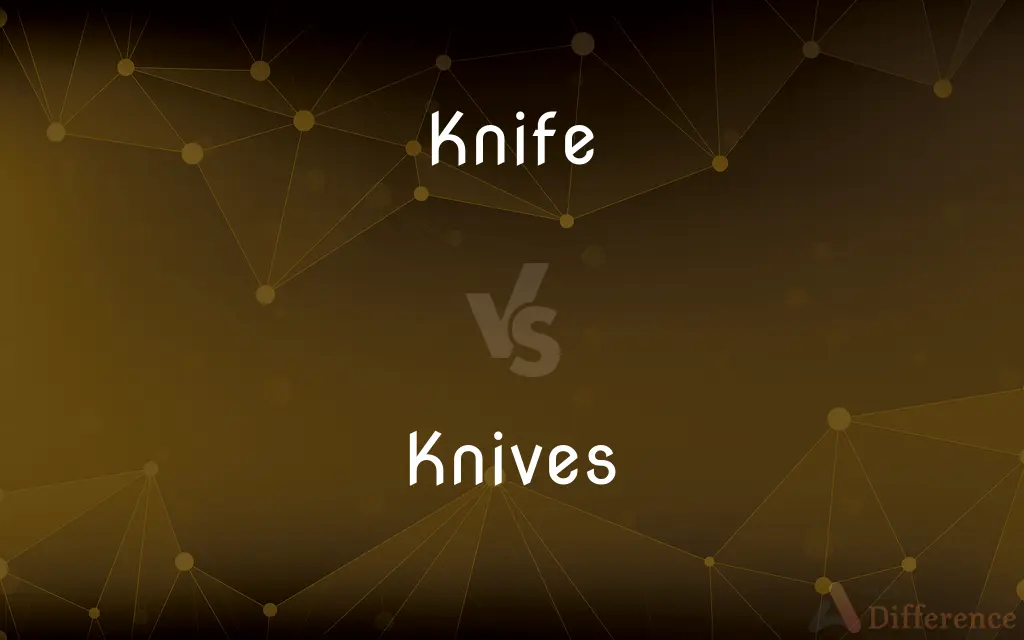Knife vs. Knives — What's the Difference?
By Tayyaba Rehman & Fiza Rafique — Updated on March 7, 2024
A knife is a single-edged cutting tool used for various purposes, while knives refer to the plural form, indicating multiple such tools.

Difference Between Knife and Knives
Table of Contents
ADVERTISEMENT
Key Differences
A knife is a versatile tool used across numerous contexts including culinary, outdoor activities, and crafting, designed typically for cutting, slicing, or stabbing. Whereas knives encompass the collective range of these tools, indicating possession or use of more than one, which could vary in size, shape, and purpose.
Knives are characterized by their variety, from kitchen knives for food preparation to tactical knives for survival or defense. A single knife, on the other hand, is often selected for a specific task based on its design, such as a chef's knife for chopping vegetables.
A knife requires regular sharpening, cleaning, and sometimes repair. Meanwhile, managing knives entails the upkeep of multiple tools, each possibly with its own specific care requirements depending on the material and blade type.
The selection process for a knife often involves considering its blade length, material, and intended use. In contrast, choosing knives might involve evaluating a set that offers a range of tools for different tasks, or assembling a personalized collection that suits an individual’s needs.
Safety precautions with a knife include proper handling, storage, and usage to prevent accidents. With knives, safety considerations extend to ensuring each is stored securely and appropriately, minimizing the risk of injury from handling multiple tools.
ADVERTISEMENT
Comparison Chart
Definition
A single cutting tool.
Multiple cutting tools.
Usage Context
Selected for a specific task.
Varied uses across tasks.
Maintenance
Individual care required.
Collective upkeep needed.
Selection Criteria
Blade length, material.
Range for different tasks.
Safety Precautions
Proper handling and storage.
Secure and appropriate storage for multiple tools.
Compare with Definitions
Knife
A tool for cutting or slicing with a sharp blade.
She used a knife to slice the bread.
Knives
Weapons with sharp blades.
The display case contained several historic knives.
Knife
A tool used in crafts for precise cutting.
She wielded the knife carefully to cut the fabric.
Knives
Tools for cutting, each designed for specific tasks.
The chef's collection of knives is extensive.
Knife
A weapon with a sharp blade.
The hunter carried a knife for protection.
Knives
Multiple utensils used in food preparation.
Her kitchen drawer is filled with knives of all sizes.
Knife
A utensil used in food preparation.
He sharpened the knife before dicing the onions.
Knives
Implements carried for various outdoor activities.
Their backpacks were equipped with knives for survival.
Knife
An implement for various outdoor activities.
He always packs a knife on his camping trips.
Knives
Tools used in crafts for different cutting needs.
The artist uses different knives to sculpt his creations.
Knife
A knife (plural knives; from Old Norse knifr 'knife, dirk') is a tool or weapon with a cutting edge or blade, often attached to a handle or hilt. One of the earliest tools used by humanity, knives appeared at least 2.5 million years ago, as evidenced by the Oldowan tools.
Knives
Plural of knife.
Knife
A cutting instrument consisting of a sharp blade attached to a handle.
Knives
Plural of knife
Knife
A cutting edge; a blade.
Knife
To use a knife on, especially to stab; wound with a knife.
Knife
(Informal) To betray or attempt to defeat by underhand means.
Knife
To cut or slash a way through something with or as if with a knife
The boat knifed through the waves.
Knife
A utensil or a tool designed for cutting, consisting of a flat piece of hard material, usually steel or other metal (the blade), usually sharpened on one edge, attached to a handle. The blade may be pointed for piercing.
Knife
A weapon designed with the aforementioned specifications intended for slashing and/or stabbing and too short to be called a sword. A dagger.
Knife
Any blade-like part in a tool or a machine designed for cutting, such as that of a chipper.
Knife
(transitive) To cut with a knife.
Knife
(transitive) To use a knife to injure or kill by stabbing, slashing, or otherwise using the sharp edge of the knife as a weapon.
She was repeatedly knifed in the chest.
Knife
(intransitive) To cut through as if with a knife.
The boat knifed through the water.
Knife
(transitive) To betray, especially in the context of a political slate.
Knife
(transitive) To positively ignore, especially in order to denigrate; compare cut.
Knife
An instrument consisting of a thin blade, usually of steel and having a sharp edge for cutting, fastened to a handle, but of many different forms and names for different uses; as, table knife, drawing knife, putty knife, pallet knife, pocketknife, penknife, chopping knife, etc..
Knife
A sword or dagger.
The coward conquest of a wretch's knife.
Knife
To prune with the knife.
Knife
To cut or stab with a knife.
Knife
Fig.: To stab in the back; to try to defeat by underhand means, esp. in politics; to vote or work secretly against (a candidate of one's own party).
Knife
Edge tool used as a cutting instrument; has a pointed blade with a sharp edge and a handle
Knife
A weapon with a handle and blade with a sharp point
Knife
Any long thin projection that is transient;
Tongues of flame licked at the walls
Rifles exploded quick knives of fire into the dark
Common Curiosities
What is the primary function of a knife?
A knife's primary function is cutting or slicing through materials like food, paper, or rope.
How do knives vary?
Knives vary in size, shape, and purpose, including kitchen knives for cooking and pocket knives for everyday carry.
How does one choose a knife?
Choosing a knife involves considering its intended use, material, and ergonomic design for comfortable handling.
Can knives be part of a set?
Yes, knives often come in sets designed for specific tasks, especially in culinary contexts.
What safety measures should be taken with knives?
Safety measures include proper handling, using the right knife for the task, and storing them safely to prevent accidents.
Is a knife considered a tool or a weapon?
It can be considered both, depending on its design and intended use.
Can a knife be a collectible item?
Yes, knives, especially those with historical or artistic value, can be collectible items.
How can one safely store knives?
Knives can be safely stored in a knife block, sheath, or drawer with protective slots.
Why is maintenance important for a knife?
Proper maintenance, including sharpening and cleaning, ensures a knife's longevity and performance.
How often should knives be sharpened?
The frequency depends on use but generally when they start to dull to maintain effectiveness.
What is the difference between a folding and a fixed-blade knife?
A folding knife has a blade that tucks into the handle, while a fixed-blade knife does not fold and is typically more robust.
Is it necessary to have multiple knives?
In many contexts, such as cooking, having multiple knives for different tasks is beneficial.
Are all knives designed for kitchen use?
No, while many are designed for kitchen use, others are intended for outdoor activities, crafts, or as weapons.
Can knives be used for self-defense?
Yes, some knives are designed for self-defense or tactical purposes, emphasizing portability and accessibility.
What materials are knives typically made from?
Knives are typically made from metals like steel or ceramics, with handles of various materials.
Share Your Discovery

Previous Comparison
Sky vs. Skies
Next Comparison
Invigilator vs. ProctorAuthor Spotlight
Written by
Tayyaba RehmanTayyaba Rehman is a distinguished writer, currently serving as a primary contributor to askdifference.com. As a researcher in semantics and etymology, Tayyaba's passion for the complexity of languages and their distinctions has found a perfect home on the platform. Tayyaba delves into the intricacies of language, distinguishing between commonly confused words and phrases, thereby providing clarity for readers worldwide.
Co-written by
Fiza RafiqueFiza Rafique is a skilled content writer at AskDifference.com, where she meticulously refines and enhances written pieces. Drawing from her vast editorial expertise, Fiza ensures clarity, accuracy, and precision in every article. Passionate about language, she continually seeks to elevate the quality of content for readers worldwide.














































